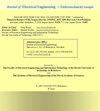Effects of metal layers on chemical vapor deposition of diamond films
IF 1.2
4区 工程技术
Q4 ENGINEERING, ELECTRICAL & ELECTRONIC
Journal of Electrical Engineering-elektrotechnicky Casopis
Pub Date : 2022-09-01
DOI:10.2478/jee-2022-0047
引用次数: 0
Abstract
Abstract Diamond is recognized as one of the most promising wide bandgap materials for advanced electronic applications. However, for many practical uses, hybrid diamond growth combining metal electrodes is often demanded. Here, we present the influence of thin metal (Ni, Ir, Au) layers on diamond growth by microwave plasma chemical vapor deposition (MWCVD) employing two different concepts. In the first concept, a flat substrate (GaN) was initially coated with a thin metal layer, then exposed to the diamond MWCVD process. In the second concept, the thin diamond film was firstly formed, then it was overcoated with the metal layer and finally, once again exposed to the diamond MWCVD. It should be mentioned that this concept allows the implementation of the metal electrode into the diamond bulk. It was confirmed that the Ni thin films (15 nm) hinder the formation of diamond crystals resulting in the formation of an amorphous carbon layer. Contrary to this finding, the Ir layer resulted in a successful overgrowth by the fully closed diamond film. However, by employing concept 2 (ie hybrid diamond/metal/diamond composite), the thin Ir layer was found to be unstable and transferred into the isolated clusters, which were overgrown by the diamond film. Using the Au/Ir (30/15 nm) bilayer system stabilized the metallization and no diamond growth was observed on the metal layer.金属层对金刚石薄膜化学气相沉积的影响
摘要金刚石被认为是先进电子应用中最有前途的宽带隙材料之一。然而,对于许多实际应用,经常需要结合金属电极的混合金刚石生长。在这里,我们提出了薄金属(Ni、Ir、Au)层对采用两种不同概念的微波等离子体化学气相沉积(MWCVD)生长金刚石的影响。在第一个概念中,首先用薄金属层涂覆平坦衬底(GaN),然后暴露于金刚石MWCVD工艺。在第二个概念中,首先形成薄金刚石膜,然后用金属层覆盖,最后再次暴露于金刚石MWCVD。应该提到的是,该概念允许将金属电极实施到金刚石块中。证实了Ni薄膜(15nm)阻碍了金刚石晶体的形成,从而形成了无定形碳层。与这一发现相反,Ir层导致了完全封闭的金刚石膜的成功过度生长。然而,通过采用概念2(即混合金刚石/金属/金刚石复合材料),发现薄Ir层是不稳定的,并转移到被金刚石膜过度生长的孤立团簇中。使用Au/Ir(30/15nm)双层系统稳定了金属化,并且在金属层上没有观察到金刚石生长。
本文章由计算机程序翻译,如有差异,请以英文原文为准。
求助全文
约1分钟内获得全文
求助全文
来源期刊
CiteScore
1.70
自引率
12.50%
发文量
40
审稿时长
6-12 weeks
期刊介绍:
The joint publication of the Slovak University of Technology, Faculty of Electrical Engineering and Information Technology, and of the Slovak Academy of Sciences, Institute of Electrical Engineering, is a wide-scope journal published bimonthly and comprising.
-Automation and Control-
Computer Engineering-
Electronics and Microelectronics-
Electro-physics and Electromagnetism-
Material Science-
Measurement and Metrology-
Power Engineering and Energy Conversion-
Signal Processing and Telecommunications

 求助内容:
求助内容: 应助结果提醒方式:
应助结果提醒方式:


